The settlements of Greenland’s eastern coast are trapped in a decimating population slide

Greenland’s settlements are in the process of a worrisome decline in population. Take Kulusuk (pictured), for example. A first-time visitor to the east coast settlement of 294 people would notice there are lots of abandoned homes. Return visitors would notice that the number is on the increase.
One of those people who has a good idea of how quickly things are going downhill is Jóhanna Björk Sveinbjörnsdóttir, who described her observations in an article carried by France24, a French news outlet, last month. Sveinbjörnsdóttir, an Icelandic anthropologist living in Berlin, has traveled to Kulusuk each summer since 2013 to work in the local hotel. While there, she has made careful note of the settlement’s decline.
“Last summer, I counted 81 abandoned homes, which is out of out of a total of only 149 homes in the entire village. There are only 250 people left in Kulusuk and the number keeps dropping,” Sveinbjörnsdóttir writes.
For Sveinbjörnsdóttir, it is the continuing transition from traditional lifestyle to a modern one that is driving the decline of the settlement’s population.
“Young people from Kulusuk don’t see any reason to stay. Previous generations grew up hunting, but these traditions are being lost with the onset of climate change. Young people who go to school dream of discovering the ‘modern world’ that they hear so much about. In reality, they don’t have any concrete knowledge of what lies beyond their village and so their imaginations run wild,” she writes.
Justus Poulsen, the chair of Kulusuk’s residents’ council, is familiar with Sveinbjörnsdóttir and says her observations are correct. Speaking with AG, a newspaper published by The Arctic Journal’s parent company, he says the settlement would like to tear down 20 or so of the worst homes, but can’t until the owners give their permission.
Poulsen, like the other residents of Kulusuk, tries to find the bright spots on the settlement’s horizon. Often, he admits, they are hard to see.
“If we want things to get better, we need jobs. Fish-processing plants is a possibility. If that happens, then we can turn things around,” he says.
Those who have heard of Kulusuk probably know it more as the site of an airport. But that status is threatened by a plan to build an airport near Tasiilaq, a nearby town, and home to 2,000 people. If that happens, Poulsen believes Kulusuk’s outlook would dim considerably, not least because most of the settlement’s residents work at the airport.
“Of course we’re worried,” he says.
He, like the rest of the town’s residents are clinging to the hope that, because the weather conditions in Tasiilaq make it more difficult to land there, Kulusuk will remain open. He also notes that Kulusuk’s runway measures two kilometers, long enough for a passenger jet, should that be necessary. The airport being planned for Tasiilaq will only be 700 meters, a tight squeeze for even the smallest of planes.
Kommuneqarfik Sermersooq, the municipal authority that governs Kulusuk, and which is based in Nuuk, some 700 kilometers away, has drawn up a four-year plan stretching until 2021 that aims to help elected municipal officials decide where to prioritize their limited resources. The cold, hard facts would seem to speak against putting them in places like Kulusuk.
Since 1994, its population has declined 24 percent. During the same period, the average age of the people still living there has increased considerably. And, those who do live there have a lower standard of living, according to the municipal calculation, than most other places in Sermersooq. Median annual income in Greenland is 291,000 kroner ($40,000). In Kulusuk and nearby settlements, the figure is a third lower. The root of this problem, according to municipal officials, is a lack of education. Just 24 people in settlement have completed any form of job training. Unemployment is 17 percent and 13 percent are early-age pensioners.
Somehow, there are other settlements that are doing worse than Kulusuk. Tiilerilaaq, located some 40 kilometers north of Tasiilaq, has lost 42 percent of its population since 1994, and now has just 112 residents. Most of those who have moved away, according Kommuneqarfik Sermersooq’s findings, have done so in search of adequate housing.
Other settlements can tell similar stories: Kuummiit, pop. 309, is the largest settlement on the eastern coast, but has lost 140 residents since 1994. Isertoq: 1993, pop. 190; today, pop. 82, none of them with job training. In the years to come, Isertoq is going to experience a “significant increase in the number of elderly living there,” say municipal authorities.
Decline is not unique to Greenland’s eastern coast. Arsuk, a settlement some 134 kilometers from the town of Paamiut, is home to 98 people, down 65 percent since 1994, the largest decline in Kommuneqarfik Sermersooq. Kapisilit, near Nuuk, has lost half of its population during the same period. Its population is now 60.
For Sveinbjörnsdóttir, worse than people leaving is, perhaps, the way they do it. “When they go, many people don’t even bother to pack up their homes. Instead, they leave them in the same state, because they want to believe that they are only leaving the town on a temporary basis. However, in reality, many of them never come back,” she writes.
This article originally ran in the March 29 edition of AG, a Greenlandic weekly published by The Arctic Journal’s parent company.